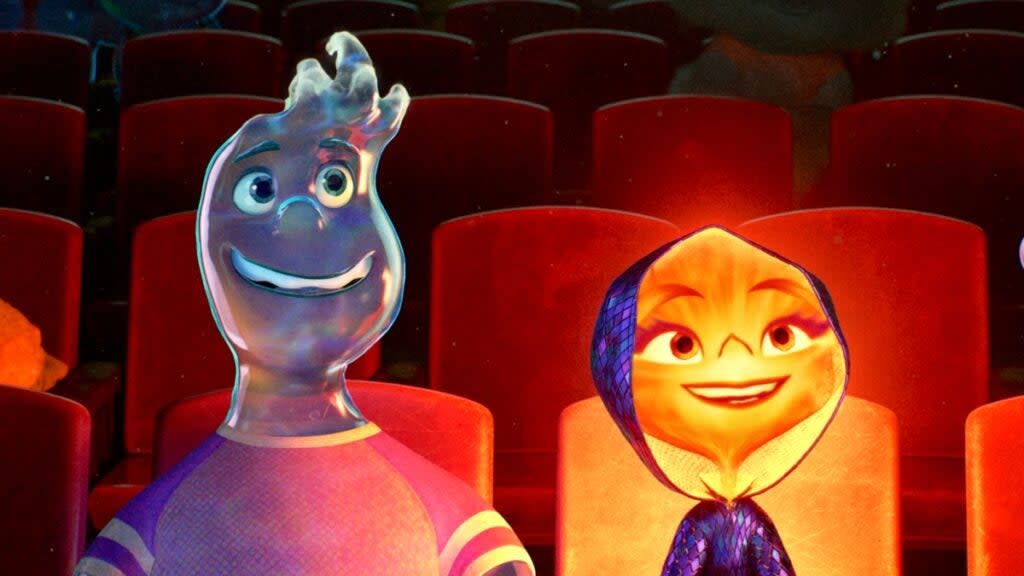‘Elemental’ Is an Immigrant Tale, but It Also Cuts Deep as a Story About Disability (Commentary)

Disney and Pixar’s latest animated feature, “Elemental,” is a charming drama about family and identity, centering the story of two elements, Ember and Wade (voiced by Leah Lewis and Mamoudou Athie, respectively), who fall in love with each other. Many different themes are tackled within, from questions of personal identity to the struggles of immigration. But at a certain point Ember talks about how, as a fire element who can cause things to ignite just by standing next to them, the “world is not designed for me.”
My ears immediately perked up when I heard that line. As a disabled person, I say this regularly because the world is definitely not designed with me in mind, or most disabled people for that matter. Director Peter Sohn and co-screenwriters John Hoberg and Kat Likkel didn’t intend to tell a disabled story, but the story they told is one that does resonate with marginalized people. “The idea of belonging and not fitting in has so many gateways,” Sohn told TheWrap.
And in the case of “Elemental,” Ember doesn’t just struggle with not fitting in because of her obligation to be a good daughter to her immigrant family. As a fire element, we watch her struggle to get onto public transportation without singeing anyone. Even visiting Wade’s water-centric apartment requires her to worry about falling into the open living room, filled with water.
As a disabled person, these moments felt painfully real: too often I worry about making friends who might feel it’s just too hard to adapt plans or their homes purely to accommodate me. It’s why seeing Wade make an effort to improve his house so Ember can sit down to dinner is so heartening. Part of Wade’s love for Ember manifests as a desire to make things accessible for her, to make her feel included.
Screenwriter John Hoberg said the creation of Fire Town, for Ember’s family, comes as a result of other neighborhoods in Element City not wanting to cater to fire people (try finding an accessible apartment in Los Angeles), and thus the story became a desire to showcase how, unintentionally, society can make things harder on people without knowing it. “It was all of us feeling like there are struggles that people have that [other] people aren’t aware of,” he said.
Even Ember’s desire to be a good daughter connects with a disabled perspective. Too often, we put the blame on ourselves for requiring more accommodations, especially at home. Ember sublimating her own desires to stick to what her family wants is no different than a disabled person’s desire to get a high-paying job to support their family as a form of thanks or take the easiest route in life to avoid requiring too much.
Disabled films have always centered characters as being angry and bitter, but watching “Elemental,” I thought of a subset of disabled narratives, particularly in the 1980s and 1990s, that focused on war veterans — a time I call the “era of the bitter cripple.” These movies (“Born on the Fourth of July” and “Forrest Gump,” for example) showcase men who become angry and bitter as a result of their disability. There’s no nuance to these moments, and the story becomes “disabled = bitter and angry.”
But “Elemental,” if you choose to read it as a disabled story, provides that nuance.
Ember’s desire to be easy-going and a people-pleaser leaves her pushing down her feelings which present as spontaneous bursts of anger. She’s apologetic and spends the movie trying to find the source of where that anger comes from. As a disabled person, these moments connected with me. When you’re so used to putting on a bright face (gotta be a credit to the disabled community!), any instance of losing that is often seen as hostility.
Watching “Elemental,” I saw myself in Ember, and though the movie established itself as an immigrant story (which it does so well), it does truly extend out to other groups: particularly the disabled community.
Animated films have the unique ability to connect with the disabled community because their magical landscapes and versatile style allow for all possibilities. It’s easier to read into these movies as coded for disability compared to live-action films because it’s harder to suspend disbelief when seeing an able-bodied actor in a role. And with disabled characters still not being regularly written for live-action films, the community must turn to the medium that allows for our imagination to insert us there: animation.
“Elemental” doubles down on the shame of just wanting to be accepted and to be viewed as an individual. For disabled people, it’s a chance to feel seen.
“Elemental” is in theaters now.
Also Read:
‘Elemental’ Earns $2.4 Million at Thursday Box Office


